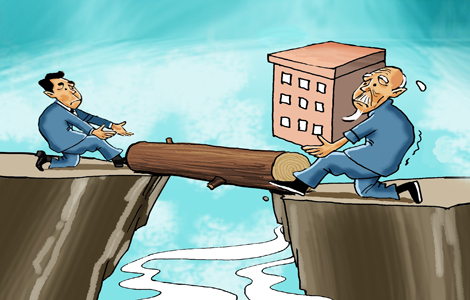Future points to carbon trading
Updated: 2013-06-14 02:17
By Lan Lan (China Daily)
|
|||||||||||
Carbon intensity
"Adopting a carbon intensity index is in line with China's commitment of reducing carbon intensity," said Yang Fuqiang, senior adviser on energy, environment and climate change for the Natural Resources Defense Council in Beijing.
China has set a target of reducing carbon intensity by 40 to 45 percent by 2020, compared with the 2005 levels.
Carbon intensity reduction leaves room for growth by allowing a limited increase of carbon emissions, said Yang.
"All approaches could be used, but the final target is to have a nationwide market, and some kind of top-level programs should be put in place," said Yang.
Most international carbon markets adopt absolute caps, but it still remains uncertain when China will reach an absolute peak in emissions.
Before the two-week climate change talks in Bonn in early June, the peak issue was already in the limelight. Some media reports said China's greenhouse gas emissions might peak before 2025 and the country might introduce a cap in 2016.
Reports about an early cap were dismissed by Su Wei, China's chief climate negotiator in Bonn, while he reaffirmed China's commitment to a carbon-intensity target by 2020.
The peak issue is part of the agenda for China in its sustainable development, but when it will happen requires more in-depth analysis, said Zhou Dadi, vice-chairman of the National Energy Advisory Committee.
Various studies have yielded wide variations for China's carbon emissions peak, ranging from 2025 to 2040.
"The year of 2025, or the period between 2025 and 2030, each has a high probability, but a precondition is China's energy demand for industrialization, which could peak by 2020, and the country could then enter a post-industrial era," said Yang.
Another key factor is the speed of China's urbanization. The quicker the process is, the earlier the country's emissions peak will come, Yang said.
Many Shenzhen businesses are willing to experiment with the new mechanism since it could also generate new business opportunities, though some power plants may be reluctant to adopt the new system, said experts who were involved in the design of the program.
The cost of environmental degradation has been largely ignored during China's impressive economic development in recent decades, putting mounting pressure on the government.
Related Stories
Airlines must reduce their emissions 2013-06-13 07:57
China reports drops in emissions of major pollutants 2013-06-04 17:46
Fewer major pollutant emissions in China 2013-06-04 17:03
Emissions peak hard to predict, expert says 2013-05-27 03:41
China's cement industry to face tougher emission rules 2013-05-24 16:19
China 'will not accept' EU measures on emissions 2013-05-18 02:25
Today's Top News
4 caught over killings of Chinese in PNG
Rudd sworn in as Australian prime minister
China slams Japan's new defense white paper
IBM to make Chinese job cuts
Building equipment sector shifts overseas
Stocks hold steady, but brokers still cautious
China can curb credit crunch: ADB official
Mandela still critical, Zuma cancels trip
Hot Topics
Lunar probe , China growth forecasts, Emission rules get tougher, China seen through 'colored lens', International board,
Editor's Picks

|

|

|

|

|

|





